Common wood pigeon
The common wood pigeon (Columba palumbus) is a large species in the dove and pigeon family. It belongs to the genus Columba and, like all pigeons and doves, belongs to the family Columbidae. It is locally known in southeast England as the "culver";[2] This name has given rise to several areas known for keeping pigeons to be named after it, such as Culver Down.
| Common wood pigeon | |
|---|---|
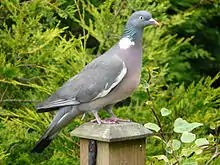 | |
| Perched on a garden fence post, England | |
| Song | |
| Scientific classification | |
| Kingdom: | Animalia |
| Phylum: | Chordata |
| Class: | Aves |
| Order: | Columbiformes |
| Family: | Columbidae |
| Genus: | Columba |
| Species: | C. palumbus |
| Binomial name | |
| Columba palumbus | |
 | |
| Global range Year-round range Summer range Winter range | |
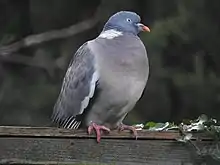
Taxonomy
The common wood pigeon was formally described by the Swedish naturalist Carl Linnaeus in 1758 in the tenth edition of his Systema Naturae. He placed it with all the other pigeons in the genus Columba and coined the binomial name Columba palumbus.[3] The specific epithet palumbus is from the Latin palumbes for a wood-pigeon.[4]
Five subspecies are recognised, one of which is now extinct:[5]
- C. p. palumbus Linnaeus, 1758 – Europe to west Siberia and Iraq; northwest Africa
- † C. p. maderensis Tschusi, 1904 – Madeira (extinct)
- C. p. azorica Hartert, 1905 – east and central Azores
- C. p. iranica (Zarudny, 1910) – southwest and north Iran to southwest Turkmenistan
- C. p. casiotis (Bonaparte, 1854) – southeast Iran to Kazakhstan to west China, northwest India and Nepal
† = Extinct
Description
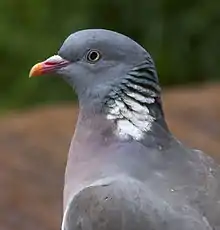
The three Western European Columba pigeons, common wood pigeon, stock dove, and rock pigeon, though superficially alike, have very distinctive characteristics; the common wood pigeon may be identified at once by its larger size at 38–44.5 cm (15.0–17.5 in) and weight 300–615 g (10.6–21.7 oz), and the white on its neck and wing.[6] It is otherwise a basically grey bird, with a pinkish breast. The wingspan can range from 68 to 80 cm (27 to 31 in) and the wing chord measures 24 to 25.4 cm (9.4 to 10.0 in). The tail measures 13.8 to 15 cm (5.4 to 5.9 in), the bill is 1.9 to 2.2 cm (0.75 to 0.87 in) and the tarsus is 2.5 to 2.8 cm (0.98 to 1.10 in).[7] Adult birds bear a series of green and white patches on their necks, and a pink patch on their chest.
Juvenile birds do not have the white patches on either side of the neck. When they are about six months old (about three months out of the nest) they gain small white patches on both sides of the neck, which gradually enlarge until they are fully formed when the bird is about 6–8 months old (approx. ages only). Juvenile birds also have a greyer beak and an overall lighter grey appearance than adult birds. The call is a characteristic cooing, coo-COO-coo-coo-coo.
Distribution and habitat
In the colder northern and eastern parts of Europe and western Asia the common wood pigeon is a migrant, but in southern and western Europe it is a well distributed and often abundant resident. In Great Britain wood pigeons are commonly seen in parks and gardens[8] and are seen with increasing numbers in towns and cities.
Behaviour
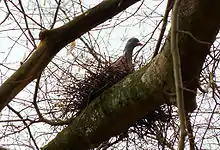
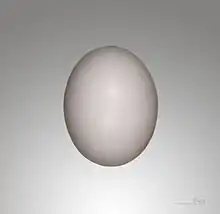

Its flight is quick, performed by regular beats, with an occasional sharp flick of the wings, characteristic of pigeons in general. It takes off with a loud clattering. It perches well, and in its nuptial display walks along a horizontal branch with swelled neck, lowered wings, and fanned tail. During the display flight the bird climbs, the wings are smartly cracked like a whiplash, and the bird glides down on stiff wings. The common wood pigeon is gregarious, often forming very large flocks outside the breeding season. Like many species of pigeon, wood pigeons take advantage of trees and buildings to gain a vantage point over the surrounding area, and their distinctive call means that they are usually heard before they are seen.
This species can be an agricultural pest, and it is often shot, being a legal quarry species in most European countries. It is wary in rural areas, but often quite tame where it is not persecuted.
Breeding
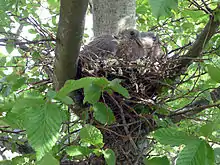
It breeds in trees in woods, parks and gardens, laying two white eggs in a simple stick nest which hatch after 17 to 19 days. Wood pigeons seem to have a preference for trees near roadways and rivers. Males exhibit aggressive behaviour towards each other during the breeding season by jumping and flapping wings at each other. Their plumage becomes much darker, especially the head, during hot summer periods. Breeding can happen year round if there is food abundant however breeding season most commonly occurs in autumn usually in the months of August and September.
The nests are vulnerable to attack, particularly by crows, because they live in the countryside, the more so early in the year when the leaf cover is not fully formed. The young usually fly at 33 to 34 days; however, if the nest is disturbed, some young may be able to survive having left the nest as early as 20 days from hatching.
In a study carried out using ring-recovery data, the survival rate for juveniles in their first year was 52 per cent, and the adult annual survival rate was 61 per cent.[9] For birds that survive the first year the typical lifespan is thus only three years,[10] but the maximum recorded age is 17 years and 8 months for a bird ringed and recovered on the Orkney Islands.[11][12]
Diet
Most of its diet is vegetable, round and fleshy leaves from Caryophyllaceae, Asteraceae, and cruciferous vegetables taken from open fields or gardens and lawns; young shoots and seedlings are favoured, and it will take grain, pine nuts, and certain fruits and berries. In the autumn they also eat figs and acorns, and in winter buds of trees and bushes. They will also eat larvae, ants, and small worms. They need open water to drink and bathe in. Young common wood pigeons swiftly become fat, as a result of the crop milk they are fed by their parents. This is an extremely rich fluid that is produced in the adult birds' crops during the breeding season.[13][14]
References
- BirdLife International (2012). "Columba palumbus". IUCN Red List of Threatened Species. 2012. Retrieved 26 November 2013.
- in the Oxford English Dictionary 2nd ed., it is known as; "culver" entry, 1st sense
- Linnaeus, Carl (1758). Systema Naturae per regna tria naturae, secundum classes, ordines, genera, species, cum characteribus, differentiis, synonymis, locis (in Latin). Volume 1 (10th ed.). Holmiae:Laurentii Salvii. p. 163.
- Jobling, James A. (2010). The Helm Dictionary of Scientific Bird Names. London: Christopher Helm. p. 290. ISBN 978-1-4081-2501-4.
- Gill, Frank; Donsker, David; Rasmussen, Pamela, eds. (2020). "Pigeons". IOC World Bird List Version 10.1. International Ornithologists' Union. Retrieved 17 March 2020.
- CRC Handbook of Avian Body Masses by John B. Dunning Jr. (Editor). CRC Press (1992), ISBN 978-0-8493-4258-5.
- David Gibbs, Eustace Barnes & John Cox (2001). A Guide to the Pigeons and Doves of the World Yale University Press, ISBN 0-300-07886-2.
- Chandler, David (2007). RSPB Children's Guided To Bird Watching. p. 93. ISBN 978 0 7136 8795 8.
- Saether, B.-E. (1989). "Survival rates in relation to body weight in European birds". Ornis Scandinavica. 20 (1): 13–21. JSTOR 3676702.
- "Woodpigeon Columba palumbus Linnaeus, 1758". Bird Facts. British Trust for Ornithology. Retrieved 1 April 2020.
- "European Longevity Records". Euring. Retrieved 1 April 2020.
- "Longevity records for Britain & Ireland in 2018". British Trust for Ornithology. Retrieved 1 April 2020.
- Cramp 1985, pp. 317, 326.
- Gillespie, M. J.; Haring, V. R.; McColl, K. A.; Monaghan, P.; Donald, J. A.; Nicholas, K. R.; Moore, R. J.; Crowley, T. M. (2011). "Histological and global gene expression analysis of the 'lactating' pigeon crop". BMC Genomics. 12: 452. doi:10.1186/1471-2164-12-452.
Sources
- Cramp, Stanley; et al., eds. (1985). "Columba palumbus Woodpigeon". Handbook of the Birds of Europe the Middle East and North Africa. The Birds of the Western Palearctic. Volume IV: Terns to Woodpeckers. Oxford: Oxford University Press. pp. 311–329. ISBN 978-0-19-857507-8.
External links
| Wikimedia Commons has media related to Common Wood Pigeon. |
